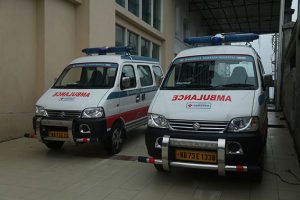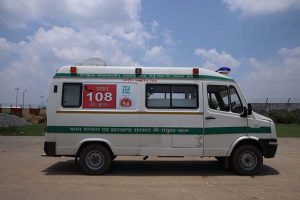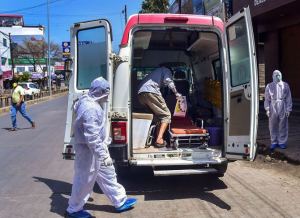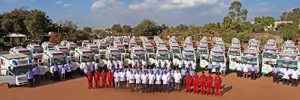Ambulances built on the Tata Winger and Force Traveller platform have been at the forefront of the fight against Covid-19 in India.
Story by Bhushan Mhapralkar
A Winger ambulance with a doctor and hospital staff, wearing N95 masks and protective gear each, rolls to a stop in front of singer Kanika Kapoor’s house. It has come to ferry her to the Sanjay Gandhi PGIMS hospital after testing positive for Novel Coronavirus. With a travel history to the United Kingdom, Sanika soon boards the Winger ambulance and get one her way to the hospital. Marking a drastic change in how emergency services have come to be, the Winger ambulance that carried Kapoor to the hospital is one of the roughly 2,200 ‘108 ambulances operated by the respective state government under the National Ambulance Service (NAS). Other than Uttar Pradesh, the ‘108’ ambulance service (which can be availed for free by dialing ‘108’ to go to a government hospital) is found in several other states of India. Tracing its roots to the vision floated and carried to reality by late Dr. A.P. Ranga Rao of Andra Pradesh in response to the lack of a standardized emergency service platform making it difficult for patients to get timely help, the ’108’ ambulance service has come to overhaul the way emergency services are provided in the country.
Close to 24,000 ‘108’ ambulances are being operated across the country under the NAS. While it may be difficult to find out if the number of ambulances operating in India meets the World Health Organization (WHO) recommendation of one ambulance per one lakh people, the fact is, the ‘108’ ambulance has come to create a niche for itself by serving nearly 800 million Indians since its inception in August 2005 as a Public-Private Partnership (PPP) initiative. Said to have saved over two-million lives until now, the service is claimed to draw inspiration from the working of the British National Health Service (NHS). Coming to handle close to an estimated 300,000 calls a day, the ‘108’ ambulances are continuing to carry forward the dream of late Dr AP Ranga Rao to do something for the people; to build a robust medical emergency system. The best part about the ‘108’ ambulances is the way they are driving a much-needed structural change in how emergency medical care is delivered to India’s poorest patients in urban and rural areas.
Said to number over 4000 units of Tata Winger and Force Traveller, the 108 ambulances are said to have become a common scene on the road as they rush patients to government hospitals with their sirens blaring and their blue lights glowing. Found in two guises – as Advanced Life Support (ALS) ambulances and as Basic Life Support (BLS) ambulances, the ones in India have come to be governed by the National Ambulance Code (NAC). If the BLS ambulances include Maruti Eecos and Omnis apart from the Tata Winger and Force Traveller, ambulances doing duty in supporting the fight against Covid-19 in India are worthy of appreciation irrespective of their make or whether they are of the ALS or the BLS variety.
On the condition of not disclosing his name as he was not authorised to speak, a resident doctor at Mumbai’s Kasturba Hospital (the Mumbai region epicentre for the fight against Covid-19), over the phone, mentioned that the fight against Novel Coronavirus is being ably supported by ambulances. Stating that these vehicles are being maintained well and quarantined after every duty, he drew attention to the fleet of 108 ambulances operating in the region. These ambulances are playing a key role in the fight against the pandemic, he added. Saving the people of India the hardship of searching for an ambulance in an emergency; of not knowing to call whom, or needing to dial multiple helplines, the 108 PPP ambulance service has created a push towards standardized ambulances. It is they that have highlighted the need to have requisite equipment or expertise to stabilize the patient. Operational almost all over the country, the 108 ambulance service has also come to include private participation from corporates like GMR, BVG and ZHL. BVG has tied up with UK Specialist Ambulance Services (UKSAS) to operate 108 ambulances. Also, the Mumbai-based ZHL has come to operate boat ambulances in the state of Odisha and Kerala, claim sources.
While the boat ambulances are said to make it easier for the government medical agencies to reach out to remote locations by using in-land waterways, the surface ambulances on Tata Winger and Force Traveller platform continue to change the public outlook towards ambulances under the 108 ambulance program. Taking over from the poorly maintained government ambulances, these ones have come to set the standards. Stating that they provide ALS as well as BLS ambulance, a source close to Force Motors mentioned that these are fitted out by Pinnacle Industries. Pinnacle, he explained, has invested in a facility within the Pithampur plant of Force Motors. Complying with NAC standards, the ALS and BLS ambulances on Traveller platform come in ready to use avatar, and are categorised as ‘mobile clinics’ and ‘speciality healthcare vans’. With a doctor consulting area and patient examination area, the ambulances are also categorised as ‘health clinic on wheels’, ‘blood collection on wheels’, and as ‘vaccination vans’. The ALS and BLS vans considered the most main-stream among others are the most in demand. Force Motors, claimed the source, has been selling a good number of units. They cost between Rs.45 lakh to Rs.75 lakh, he informed. Above and over the basic vehicle cost, the seemingly higher cost of an ALS or BLS ambulance is dictated by the amount of equipment onboard.
The list of equipment, driving the cost high, on an ALS ambulance typically includes electrocardiograph, defibrillator, etc. Stating that each 108 ambulance is fitted with an advanced GPS system, and a communication platform, a Maharashtra Emergency Medical Services (MEMS) source drew attention to the back-end operation that supports the over 1000 (108) ambulances that operate all over Maharashtra. Deploying trained EMS professionals that can early-detect any emergency, respond immediately, report, provide on-scene care, en-route care and facilitate appropriate hospital transfer, the MEMS operations include a state-of-the-art Emergency Response Centre (ERC) at the Aundh Chest hospital, Pune, the source revealed. It operates 24×7, he said.
Even as the shift is changing at the ERC, calls continue to come in. One call has come from Nagpur, some 900 km away, and another call has come from Latur. Those that have just taken over promptly attend to the call and ensure that emergency services are delivered. The GPS system updates the call centre desk and the ambulance staff also reports, Contact is established with the hospital so that the casualty staff there is ready to handle the emergency. If the ‘108’ ambulances have come to set the standards for emergence services in India, they along with the many private ambulances are ensuring that pandemics like the Novel Coronavirus are dealt with effectively and quickly. When Singer Kanika Kapoor will be cleared of the Novel Coronavirus infection and discharged, it is quite likely that a ‘108’ ambulance will ferry her home in an environment that is of the standard necessary and is safe and secure in nature.


























